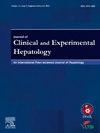Human Fascioliasis a Silent Menace: Case Report With Review of Literature
IF 3.3
Q2 GASTROENTEROLOGY & HEPATOLOGY
Journal of Clinical and Experimental Hepatology
Pub Date : 2025-01-09
DOI:10.1016/j.jceh.2024.102493
引用次数: 0
Abstract
Fascioliasis is a tropical zoonotic disease caused by liver flukes (Fasciola hepatica and Fasciola gigantica) mostly in sheep, goats, and cattle. It is a prevalent infection in developing countries like Bolivia, Peru, and Egypt, affecting both humans and livestock. It remains under-reported due to lack of awareness. Humans accidentally acquire it by consuming contaminated watercress or water contaminated with infective metacercaria. It affects the hepatobiliary system, manifesting as tender hepatomegaly, bile duct obstruction, liver fibrosis, and secondary cholangitis. Diagnosing fascioliasis is a challenge as it presents with nonspecific symptoms like prolonged fever, anorexia, ascites, and with limited availability of testing. Triclabendazole, currently the only approved drug, is unavailable in India. Fascioliasis has been reported only in reports from India. We here report a case of a 4-year-old patient who presented with fever and tender hepatomegaly. Hepatobiliary imaging showed infiltrative liver disease with small cystic lesions and periportal thickening. Liver biopsy showed microabscesses with eosinophilic infiltration. The patient was tested for Fasciola IgG antibody, which was positive. Triclabendazole was procured from Geneva for treatment. Through this report, we highlight this neglected parasitic infection that presented in a nonendemic region that needs improved diagnostic tools, increased awareness, and control measures to mitigate the disease.
人类片形吸虫病是一种无声的威胁:病例报告并文献复习
片吸虫病是一种由肝吸虫(肝片吸虫和巨型片吸虫)引起的热带人畜共患疾病,主要发生在绵羊、山羊和牛身上。它是玻利维亚、秘鲁和埃及等发展中国家的一种流行传染病,影响人类和牲畜。由于缺乏认识,报告仍然不足。人类通过食用被污染的豆瓣菜或被传染性囊蚴感染的水而意外感染。它影响肝胆系统,表现为肝肿大、胆管阻塞、肝纤维化和继发性胆管炎。片形吸虫病的诊断是一个挑战,因为它表现为非特异性症状,如持续发烧、厌食、腹水,并且检测的可用性有限。目前唯一获得批准的药物三氯咪唑在印度是不可用的。片形吸虫病仅在印度报告过。我们在此报告一例4岁的病人,他表现为发热和肝肿大。肝胆影像学显示浸润性肝病伴小囊性病变及门静脉周围增厚。肝活检显示微脓肿伴嗜酸性粒细胞浸润。检测片形吸虫IgG抗体阳性。从日内瓦采购了三氯咪唑用于治疗。通过本报告,我们强调在非流行地区出现的这种被忽视的寄生虫感染,需要改进诊断工具,提高认识和采取控制措施来减轻疾病。
本文章由计算机程序翻译,如有差异,请以英文原文为准。
求助全文
约1分钟内获得全文
求助全文
来源期刊

Journal of Clinical and Experimental Hepatology
GASTROENTEROLOGY & HEPATOLOGY-
CiteScore
4.90
自引率
16.70%
发文量
537
审稿时长
64 days
 求助内容:
求助内容: 应助结果提醒方式:
应助结果提醒方式:


